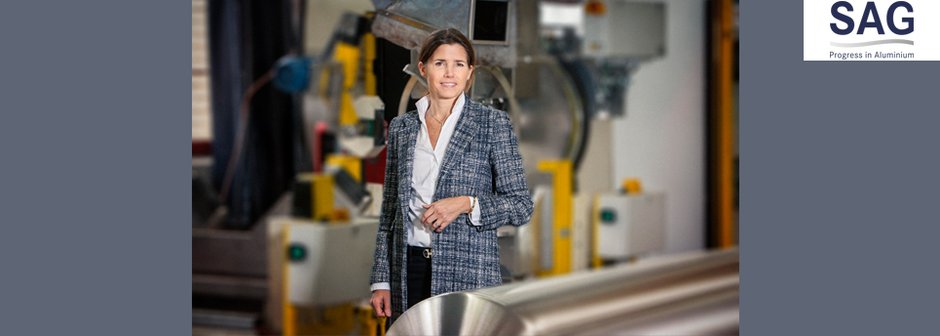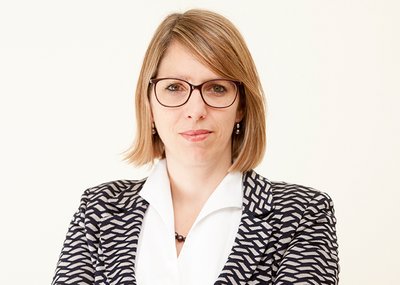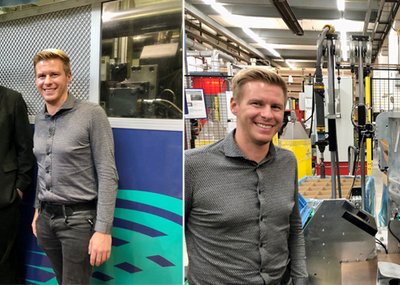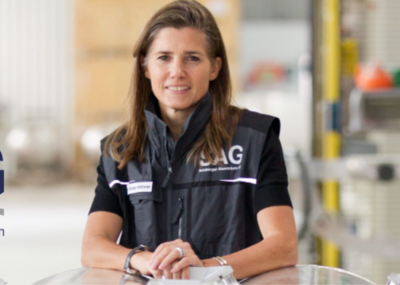It's a sunny summer day, both in Vienna and in Salzburg. This is evident because Karin Exner-Wöhrer has sat down on the terrace of the headquarters of the Salzburg Aluminium Group for our interview. The laptop is enough for a zoom call, why should she sit there in her certainly chic CEO's office when she can also have the Salzburg mountainscape around her in complete relaxation? And with that, she also highlights one of the themes of this time: digitalisation. Especially for internationally established and traditional companies - SAG is the third oldest aluminium plant in the world - this is not an easy development, one would think. Not from the point of view of this dynamic boss. So how does the 49-year-old deal with the current challenges? A conversation about surprises, worries and solutions that require courage. And assertiveness.
SAG
Karin Exner-Wöhrer, CEO of SAG: "Today we can talk to India in ten minutes, if we want, or to Japan. From my point of view, Corona has shown that although everything takes about longer, it is just as possible."
During the lockdowns, you succeeded in preparing the US market for SAG and gaining a foothold there. Do distances no longer play any role at all in today's world?
We were actually still pursuing plans to go to North America during Trump's time. We have worked the market before, but mainly from the two locations in Mexico and Canada. After all, we realised two or three years ago that there was a lot of potential in the USA for our products - we are primarily targeting the passenger car segment, i.e. SUVs and light trucks. Then Corona came along, and until recently (see story: SAG goes USA) we had to operate from a distance. And I can say that we expected much bigger hurdles in the process.
We assumed that our products were very consultation-intensive and convinced ourselves that this could only be conveyed through personal contact. However, the responsible colleagues then succeeded in landing two large orders in a purely digital way. From this we can actually deduce that distances no longer exist as barriers in this sense. Today, we can talk to India in ten minutes if we want to, or to Japan. From my point of view, Corona has shown that although everything takes about longer, it is just as possible. In this respect, we have learned a lot. But now we hope that we can speed up the processes even more with the location in the USA that has finally been realised.
The new location only became possible for SAG after the change of presidency. Has so much changed under Joe Biden?
In any case, the big bureaucratic hurdles of simple entry for someone who wants to live there with family have been loosened very quickly. In my view, however, the motto "America First" has not changed much.
US companies in particular are currently complaining about a glaring shortage of chips and other relevant components. How does that look in your industry?
We are not directly affected because we don't build chips ourselves. But our customers are very much affected. Some customers were even affected very early on because the situation was underestimated. Others were able to shift the situation internally within the group a bit, so that the heavy truck segment was only affected at the very end. Now we are in a very hot phase, in which one or the other customer is extending the summer holidays in order to fill up the stocks and then to be able to get going again.
SAG
Closed ports and the lack of chips also have a wider impact on SAG's supply chain.
But it is not just about a chip shortage: many Chinese ports are still closed or have been closed again because of Corona. Interestingly, you don't read about this in our media, but it means that containers are simply stuck there and in some cases can no longer be located precisely. This is currently causing major disruptions in the supply chain, and we assume that this will not be resolved in the next three months. This problem will certainly accompany us for another six to twelve months.
Is SAG trying to find alternative ways to close these gaps? Or do you just have to live with these gaps now and certain things are delayed?
The problem of the closed ports can of course be solved alternatively. As long as the container is not yet at a port, you try to divert it to another port. That is possible, but it costs time. The problem lies more with manufacturers who have to retool or create capacities to meet demand. That takes much longer. But I believe that this problem is not fuelled by our industry, but rather by the electronics industry, the entertainment industry, which simply pulls so hard and simply pays different prices than we do. The fact is that in a free market economy, preference is given to those who pay higher prices.
Apart from the lack of raw materials, the shortage of skilled workers has become more and more obvious in recent months, especially in Austria. What are we doing wrong?
From my point of view, this is not surprising at all. We already had a shortage of skilled workers before Corona. And we also knew that this shortage of skilled workers would increase significantly in some areas. For us, it's mainly IT staff. In the area of digitalisation, we would prefer to take on ten, twenty, thirty people today. Interestingly, however, I noticed before Corona that this was very much an Austrian issue, other locations didn't feel it so much. It's different now - we are struggling with it in all countries.
What do you think is the reason for that?
It has to do with the fact that some of the established Corona benefits have led to many people preferring to take advantage of them rather than work full-time or continue their education. In retrospect, of course, one is always wiser, but I think the learning from this is that it would have made more sense to use the short-time work intensively for training or to combine the short-time work allowance with concrete further training measures. However, it has to be said that these models had to be developed very quickly in a confusing time in order to maintain people's standard of living. And that was good and important.
In connection with the shortage of skilled workers, the issue of location is also brought up again and again. Is the location of a business so relevant or often so bad in Austria?
In the meantime I have the impression that the location does not play such a big role. It's more about the overall package, which has to be right. At the moment we are trying to attract employees with two themes that we say distinguish us from others. One is great entrepreneurial freedom, i.e. a great deal of freedom of movement within the company. The other is that we work here in a place where others go on holiday. That means high recreational value and, of course, the effort to adapt our working hours and forms of work to needs.
That is great entrepreneurial freedom, so a lot of freedom of movement in the company, and that we work here in a place where others go on holiday.
Karin Exner-Wöhrer, CEO of SAG
My learning from the Corona period was that it is important for people to establish common core hours. But no longer 7 am to 4 pm like in the past. But maybe Tuesday, Wednesday, Thursday. And then on Monday not paid time off, but work at another place, for example in a home office. We try to consciously integrate such modern models into our operations where possible.
What does that mean in concrete terms for your different areas of work at SAG?
It has to be said quite clearly: there are limits. If I have to look after three small children at home who are not of school age, that means pure stress for everyone. But there are enough activities, such as this conversation with you, that I don't have to go to the office, I can do that from anywhere with teams or Zoom. We do this internationally at all our locations, why shouldn't it work locally? For employees who have to travel about an hour, this is also a relevant option, because on some days they simply have more time for themselves. But: I don't get the IT professionals I'm looking for in Vienna either, or elsewhere. Even if we were to offer that he or she could work entirely in a home office, in our experience that doesn't help. I would have to go to Bulgaria or India. And that's the big danger: once I'm there, I won't come back. Once you're gone, you're gone.
That is certainly a danger. India and Pakistan, in particular, are already making a big international impact. Especially since you get performance at a lower price ...
These are top people! You don't have to believe that they are less productive. They don't have five weeks' holiday either. And as a company you have the advantage of being able to play with the time difference. The people there work when it's nighttime here, and the very next day we can continue working on the basis of that. There are many advantages.
But you still don't use these options?
Well, we fail because of our own psychology, that we actually don't want to approve of it. Nevertheless, there is a clear mandate that we have to deal with it out of necessity. Currently, we are at the stage of trying to define services that we could let go offshore. This is basically very close to home office considerations. Not because we want this in principle, but out of necessity!
It is probably also necessary to take politics into account. What do you think should be done?
I think the already well-established STEM activities in the kindergartens are fantastic. But the big problem is that I won't have anything to gain from them for another 20 years. It won't solve my skilled worker problem now or in five years. What can we do now? I'm thinking, for example, of women who go on maternity leave. Men do it too, that's clear, but to a vanishingly small extent. I think we could really make good use of this maternity leave. And as a mother of three children myself, I know what I'm talking about. You could really push digital education in the digital segment here. And of course I have to be much more aware of attracting 15 to 17-year-olds to these areas. I have to advertise it better, make them want it, show them the opportunities.
SAG
Digitalisation is changing communication and thus also the future labour market. Teenagers have to learn to understand and use digital ways in the course of their education. Karin Exner-Wöhrer, CEO of SAG, is also convinced of this.
And, this is now completely politically incorrect, but what do I expect from a 55-year-old teacher who himself has difficulty with the iPad? He won't get children and young people excited about digital worlds. Just one example: We have the great university of applied sciences in Salzburg. And it doesn't have the problem that there are too few places to study - it doesn't get the available places filled! So we simply have too few graduates, although more would be possible. That's why I see the bottleneck in the teenagers who need to be inspired - whether to study at a university of applied sciences or to teach in this spectrum.
But, strangely enough, teaching simply doesn't manage to establish an exciting image. Why is that?
I am a great friend of teaching. I think it's a great form of education. It just needs to be digitalised. Because today I have to expect a machinist to understand and use digital methods for his work. The way there wouldn't be far at all: the most digital thing at our school is still the break (grins). The children can all happily and permanently use their devices during the breaks. But at work, we simply teach them not to use them, instead of building on them. I see that as a real problem. Another one with the 40 plus generation.
You'll have to explain that to me in more detail now ...
The group of 40 plus year-olds is just as neglected in this area. I'm not talking about us who sit in the office and work with digital communication possibilities every day. I'm talking about our welders, my employees in production, who will have a completely different job in five years. They will no longer weld by hand, but operate a computer. And that is of course our task, to accompany them in this change, this psychological transformation. But there's no help for that. In fact, there is still very little on the market to support them in adapting and expanding their mindset.
Does this mean that you have no chance to train your staff at SAG because the courses are not available?
We could solve it ourselves in-house. But that is not efficient from a business point of view. It would be much more efficient if we could buy in relevant e-learning courses, for example.
About SAG:
SAG is an internationally active company with Austrian origins. Thanks to highly trained employees, tank solutions and lightweight components for vehicle construction are developed and produced at a total of ten branches in Europe and Mexico. The R&D know-how and the product and service portfolio are constantly being expanded. SAG is a technology leader in many areas of the materials sector and in the cryogenic tank sector.
Aluminium brings lightness to vehicle construction. Due to its low weight and corrosion resistance, it has excellent mechanical properties. In addition, it is extremely versatile, 100% recyclable without any loss of quality and thus a very resource-saving raw material.
Karin Exner-Wöhrer ...... is the mother of three children and has been CEO of the Salzburger Aluminium Group (SAG) since 2010. She holds a doctorate in business administration, is a former Austrian golf champion and wrote the highly acclaimed book "So delicate and yet so strong.
Source: Fakt & Faktor








